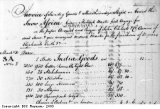Luxuries from abroad
The products grown by slaves on the Caribbean plantations and imported into Europe were mostly ‘luxuries’. The slave plantations in the Caribbean were not growing ‘staples’, basic foods like wheat for bread, or potatoes for the local market. They were producing goods seen by those in Europe as luxury items. These were mostly sugar and tobacco, and rum, rice, indigo (a blue dye from a plant) and cotton. Tropical woods, cut down on the islands or imported from the coast of South America, were also luxury imports.
A poem by William Cowper was published in the Bristol Gazette newspaper on 12 June 1788. It made fun of the growing demand for these luxury goods. The irony was, that the goods wanted by the kind-hearted British were being produced by slave labour. As awful as this was to them, they did not want to give up their sweet drinks so they kept quiet (or ‘mum’) about the slave trade. Part of the poem was as follows:
I own I am shocked at the purchase of slaves …
I pity them greatly,but I must be mum,
For how could we do without sugar and rum?
Especially sugar, so needful we see
What, give up our dessert, our coffee and tea?
The trade in luxury goods was a complex one. There were goods being brought to Europe from a wide number of places around the world. European ships going to West Africa to buy slaves also bought goods such as gold, ivory or tropical wood. After crossing the Atlantic Ocean, the ships loaded up with other goods, such as sugar and tobacco from the Caribbean plantations. This mixed cargo of goods would then be transported back to Europe for processing and sale as luxury items.
Cotton and silk textiles from India were bought to Britain by the East India Company (a trading company based in London). The cloth was bought by merchants around the country and taken to Africa as part of the cargoes of trade goods used to buy enslaved Africans. This page from the accounts book of the Bristol slave ship the Africa, shows the large amounts of cloth from India onboard. The different types of cloths listed have Indian names. European merchants were also trading in tea and coffee, which they bought from China and the Middle East. This trade encouraged the import of sugar from the Caribbean. The newly fashionable tea, coffee and chocolate drinks were bitter and needed sugar to sweeten them to taste.




